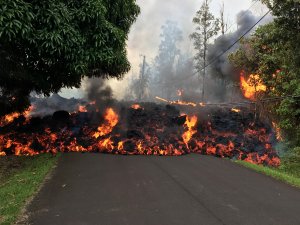President Donald Trump declared a major disaster in Hawaii after days of volcanic activity that sent molten lava and toxic fumes spewing into residential neighborhoods.
The declaration allows federal assistance to supplement state and local recovery efforts in areas affected by the Kilauea volcanic eruption and earthquake.

Federal funding is available to state, eligible local governments and certain private nonprofit organizations on a cost-sharing basis, the White House said.
The Kilauea volcano erupted on May 3, leaving the future of hundreds of people in Hawaii’s Big Island uncertain.
The threat of violent explosions prompted authorities to close the Hawaii Volcanoes National Park on Friday until further notice.
15 vents
The volcanic vents on the ground that released slow-moving lava and toxic gas into island communities are still a hazard.
No lava was reported from any of the 15 vents but “additional outbreaks of lava are likely,” the US Geological Survey’s Hawaiian Volcano Observatory said.
Volunteers are assisting about 300 evacuees who have been sleeping at emergency shelters. Lawmakers are concerned it could take weeks or even months before they can return home, CNN affiliate Hawaii News Now reported.
Authorities have also allowed the nearly 2,000 evacuees to go inside their homes and pick up their belongings under the warning that they could have to rush out once again.
The estimated cost to protect residents over the next 30 days is expected to exceed $2.9 million, according to the governor’s office.
Toxic gas
Hazardous fumes continue to be released, putting the health of residents and emergency crews in danger.
There are high levels of sulfur dioxide, which can cause headaches and irritation to the lungs and eyes if it’s inhaled at higher concentrations, the University of Hawaii at Hilo says.
Erupting volcanoes spew the hazardous sulfur dioxide gas. If conditions are right, that gas and other pollutants can settle with moisture and dust to create a haze called volcanic smog, or “vog,” with tiny sulfuric acid droplets.
High levels of acidic particles in vog “can induce asthma attacks, especially in adolescents, and can also impede the ability of the upper respiratory tract to remove other potentially harmful particles,” the USGS says.
More lava?
The lava emission appears to have paused since Wednesday but scientists are warning residents of acid rain, falling ash, and eruptions that could occur Friday and in coming weeks.
The explosions would “provide very little warning,” officials say, and could send “ballistic projectiles” — from the size of small pebbles to giant rocks — into the sky.
It’s uncertain how big the explosions could be but scientists have said that Hawaii’s Kilauea volcano appears to be mimicking behavior last seen in 1924.
During nearly three weeks of activity, blocks weighing as much as 14 tons were blasted from the crater. One person was killed by falling debris. Volcanic ash was seen rising as high as 20,000 feet above sea level.
New lava outbreaks can begin “at any time” as well as “more energetic ash emissions,” the USGS warned.












